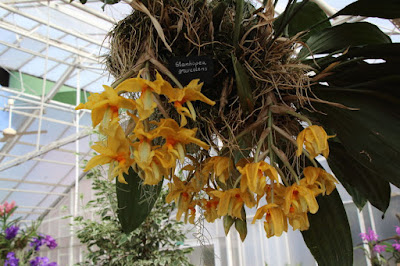Stanhopea graveolens is native to Mexico, Guatemala and Honduras, where it grows epiphytic on trees, very rarely directly on land at an altitude of 2700 meters above sea level...
Stanhopea graveolens also called as The Very Fragrant Stanhopea, Stanhopea aurata, Stanhopea aurea, Stanhopea graveolens var. aurata, Stanhopea graveolens var venusta, Stanhopea inodora, Stanhopea oculata var. constricta, Stanhopea venusta, Stanhopea venusta, Stanhopea wardii var. froebeliana, Stanhopea wardii var. venusta, is a species of the genus Stanhopea. This species was described by John Lindley in 1840.
IDENTIFY STANHOPEA GRAVEOLENS
Stanhopea graveolens is native to Mexico, Guatemala and Honduras, where it grows epiphytic on trees, very rarely directly on land at an altitude of 2700 meters above sea level.
It is a cool growing epiphyte or lithophyte with ovoid-conical to rhomboidal, sulcate, slightly compressed pseudobulbs carrying a single, apical, elliptic-lanceolate to broadly obovate-elliptic, abruptly acute, petiolate, sulcate leaves.
The few large, showy, fragrant, waxy flowers, which are incredibly complex, descend from the bottom of the plant on a short, pendulous, 1 to 6 flowered inflorescence with papery, spathe like bracts all occurring in the spring and early summer. The flowers are yellow, densely covered with brown spots, in shape resemble a flying bird. Petals and sepals grow upward. The lip is triple, its main color is orange in brown speckles, has a long spur, already at the base it is clearly delineated on a part that grows in different directions.
STANHOPEA GRAVEOLENS CARE AND CULTURE
Cultural information should only be used as a guide, and should be to be adapted to suit you. Your physical location; where you grow your plants, how much time you have to devote to their care, and many other factors, will need to be taken into account. Only then can you decide on the cultural methods that best suit you and your plants.
Light:
Stanhopea graveolens needs a light level of 15000 - 35000 lux and is able to tolerate direct morning and evening sun, however, in the hot summer noon, this orchid should be protected from direct sunlight.
Temperature:
This orchids can grown in intermediate to warm temperatures. It is recommended that the orchids be kept under the following conditions throughout the year: day temperature not higher than 27 ° C; night temperature is 11-15 ° C.
Humidity:
The Very Fragrant Stanhopea needs high humidity and rarely falls below 70%. It is necessary to regularly ventilate the room where the plants are kept, since wet, stale air is an ideal medium for the mass reproduction of various fungal and bacterial diseases.
Substrate, growing media and repotting:
The peduncles of Stanhopea graveolens grow downwards, growing through the substrate, so this kind of orchids usually be grown in suspended trellised baskets or on blocks. To protect the peduncles from decay, the substrate must be very good breathable, for this purpose, a very large bark of coniferous trees, with a small proportion of sphagnum (up to 20%), charcoal, stem and rhizome of some ferns (for example, genus Osmunda sp.). When choosing a container for planting, it should be borne in mind that their height should not exceed 10-12 cm, on the assumption that the peduncles will sprout through the substrate and come out from the lower side (the length of the peduncles is 15 cm). If the height of the basket is longer than the peduncles, they will remain inside the substrate or the opening of the flowers will occur at the bottom of the basket, which is fraught with deformation due to lack of space. When growing orchids on blocks to prevent rapid drying of the root system of the plant, it is recommended to make a small interlayer of moss between it and the block. Above the roots, you can also put live or dry sphagnum.
Watering:
Watering directly depends on the overall temperature of the content, the higher it is, the more often and abundant it is necessary to water. Plants growing on blocks, it is desirable to water daily in the morning, so that by evening their roots could dry out relatively well. When watering orchids in pots, it is necessary to remember that excess water during watering should flow freely out of the pot, as the stagnation of water both inside the pot and in its pallet can very quickly lead to rotting of the roots and the lower part of the plant. The substrate between watering should dry relatively well, but not completely dry, i.e. is always in a slightly moistened, but not wet state.
Fertilizer:
During the new growth period, this type of orchid is fertilized once a week at 1/2 of the fertilizer concentration indicated on the package. At the beginning of the growing season (the appearance of new shoots) it is recommended to use a fertilizer with a high nitrogen content, and by the time when new shoots reach 1/2 of their normal size - a fertilizer with a high content of phosphorus. It is also possible to use fertilizer containing nitrogen, phosphorus and potassium in equal parts, for example, NPK = 3-3-3 or 8-8-8, etc. creating an environment unfavorable for the root system of orchids, leading in time to their mass burning.
Rest period:
Stanhopea graveolens does not need a rest period for stimulation of flowering. Refusal to flowering can be caused by a common stressful state (bad root system) of orchids, insufficient lighting or too hot content both in summer and winter. In winter, watering can somewhat reduced, but the plant can not stay dry for long period. Whenever watering is reduced, fertilization should also reduced or completely eliminated until strong watering resumes.

















COMMENTS